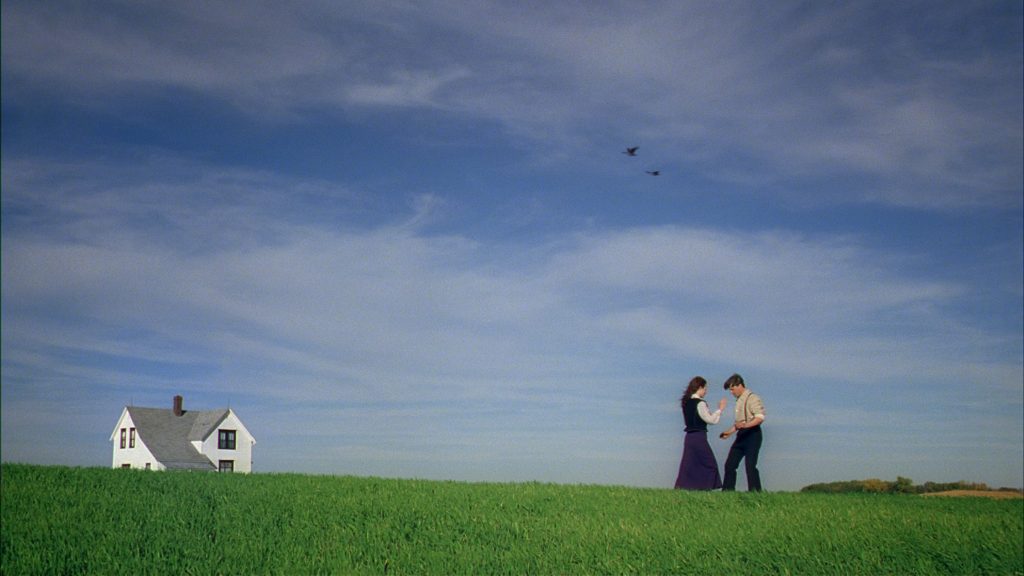What I learned by watching the same movie every night for three weeks
Let me begin with the why: why in the world would I watch the same movie every night for three weeks?
In early September Aaron traded the better part of a year’s worth of vacation to hike the Superior Hiking Trail. Those who know me know I’m not a good sleeper. Insomnia, which is already a too-frequent visitor, seems to take up permanent residence when Aaron is away. Every rattle in our 65-year-old home seems to be louder when he is gone. The wind seems to be angrier when he is away.
At the same time, every day seemed to bring a new low out of Washington: corruption, discrimination, the dismantling of environmental protections. The first days of Aaron’s absence were nearly void of sleep. I needed to do something about it. Typically I am a late-night reader, but one night I decided to watch a movie instead.
The movie, Sweet Land, tells the story of Inge who travels to rural Minnesota from Norway for an arranged marriage to a Norwegian-immigrant farmer named Olaf. The movie had been filmed in southern Minnesota. The production team found original farm houses, tractors, and an old steam engine to use; those artifacts lent deep authenticity to the sense of time and place.
I watched the movie a couple of times a decade or so ago (the movie was released in 2005). I was taken by the quiet tenderness of the love story, and over the years have told many people it is one of the sexiest movies ever, ever—even though the only thing we see is Inge and Olaf holding hands. (Inge and Olaf are played by Elizabeth Reaser and Tim Guinee.)
As I watched the movie this time, I was reminded of the romance of the story. But I was surprised by how timely the theme of the discrimination of “other” was. Sweet Land tells the story of discrimination against Inge, who had the misfortune to be a German national in the years after WWI. Prejudice against Germans combined with Inge’s lack of paperwork prevented Inge and Olaf from getting married.
The next day at work I found myself thinking about the movie, analyzing how the director, Ali Selim, wove together three languages and threads from different eras, how he could draw me into this story of land, community, and connection. He made me want Inge and Olaf to fall in love, which in itself shouldn’t have been suspenseful since we knew from the first lines of the movie they had been married 48 years.
I watched the movie again and observed new details: the intensity in a split-second glare from actor Alan Cumming (Frandsen), how the judgment-filled shake of Ned Beatty’s (Harmo’s) head rippled across the skin of his neck, the way a gentle smile from Lois Smith (Old Inge) revealed decades of stories, the shakiness in Tim Guinee’s voice as he confessed to the clerk at City Hall “she is German.” While I had seen these things in the first viewing, I hadn’t appreciated the subtlety in these performances.
I kept thinking about the movie, so I watched again the next night. Per usual, our 110-pound lab was curled next to me, snoring. This time, I paid specific attention to language. The movie incorporates German, Norwegian and English, and it does so in a way that ensures you know what’s happening, even if you don’t understand the words. Inside the railroad station, for example, even if you don’t know what “kan du lese?” means, you understand Else, another mail-order bride, asks Inge whether she can read English. From a craft perspective, I wanted to understand how Selim achieved this clarity. Sometimes he did this by repeating single words in Norwegian, then English, such as with “tung, heavy.” Other times Selim was more subtle. In the dinner scene with Harmo, Olaf mutters “velsign aldri dagen før den er ferdig.” The only way we know that means “never bless the day until it’s done” is because Harmo mockingly parrots the phrase in English.
Actress Elizabeth Reaser gets a huge shout-out for mastering lines in German and Norwegian. As you can see from the movie trailer, you’d never know she learned her lines phonetically:
Click here to watch the Sweet Land theatrical trailer. File courtesy of sweetlandmovie.com
From a craft perspective, I also noted Selim planted the question “what?” near the beginning of the movie. That same one-word question played a prominent role late in the movie. Using that single word as a “bookend” was brilliant.
Sidenote: Viewers in the Midwest will be particularly amused by the actors’ perfectly elongated ‘o’s and ‘u’s in lines such as “It’s loooocked,” “Martin Luuuuther,” and “Call me … Broooownie.”
One evening I re-read “A Gravestone Made of Wheat,” the short story by Will Weaver that inspired the movie. I purchased and read Weaver’s book of short stories after watching the movie a decade or so ago; the book had been sitting in my basement ever since. “A Gravestone Made of Wheat” introduced readers to the characters of Olaf and Inge. I analyzed the elements director Selim extracted from Weaver’s short short, contemplated why he might have changed key aspects of the story, then how he added new characters to round-out the storyline.
The Christmas before last, Aaron gave me a gift certificate for Ron Howard’s online Master Class on Directing. I wasn’t looking to become a director, rather, he just knows I enjoy movies and learning new things. I found the sections on “blocking” particularly interesting (“blocking” is choreographing an actor’s moves in relation to the camera). One night I watched Sweet Land with “blocking” in mind and noted choreographed moves such as how Olaf stomped in front the camera after arguing with Inge about which one of them was “behaving badly.” Or how, in the scene inside the train station shortly after Inge arrives, Else could have claimed a space on the bench near Inge, waiting to be claimed; instead—though our attention is on Inge—Else made her way from man to man, presumably asking if any of them were her husband-to-be. Or how, in Olaf’s final scene, he stands in profile in the stairwell so we can watch his reaction as he processes Inge’s invitation. It’s naïvely easy to believe these movements “just happen” when they look so seamless, but they don’t.
More than a few times I fell asleep mid-way through the movie. Hoorah! I appreciated the quietness of the soundtrack: the hollow, warm sounds of the violin and clarinet, the strumming of the guitar and banjo, the ring of a toy piano.
During one viewing I made a mental map of the farmhouse. Did you not take me seriously when I told you I have issues with insomnia? I was amused to realize there was a discrepancy between the placement of the kitchen door from the exterior and interior. From the exterior, the door appears in the corner of the house, but once inside, the wall extends on both sides of the door. And I realized the clothes line appears both along the side of the house and behind the house. (The scene where Inge hops out of the tub and looks out window at Olaf, then pivots to look out the back window at her clothes flapping on the clothesline would have been impossible; the clothesline was the other direction). I’m not pointing that out as a criticism; I found it fascinating that that directorial decision was made. There was no way to amplify the jeopardy of the situation without having Inge look at Olaf, then look at the clothesline; looking out a different window in that instant wasn’t an option.
Another time I paid attention to the lighting and observed how Selim, with cinematographer David Tumblety, filmed scenes at sunrise or at sunset and made use of beautiful natural light. Oh, how I wish I could have seen the movie when it was shown in a theater!
It was about this time I began wondering how this movie could have captured my attention over so many viewings. Sure, I’ve watched movies more than once before; I’ve watched Cinema Paradiso a dozen times over the years. But I’ve never watched a movie this many times. Maybe it was because I could imagine my grandmother and grandfather in the early years of their long marriage. They were loyal, hard-working dairy farmers who would have been only slightly younger than Inge and Olaf. Maybe it was because corn fields and small country churches are part of my history, or that German immigrant blood runs deep in my veins. Maybe I appreciated the charm of a summer picnic or space filled with hope and possibility. Regardless of what it was, the movie seemed to provide calm comfort at the end of what continued to be a series of days with shocking national headlines. Maybe watching the movie repeatedly allowed me to miss Aaron a little less during the month he was away.
Or, maybe it was because I continued to observe new things each time I watched: how the few articles of Inge’s wardrobe were re-combined. Or that there was a mid-scene wardrobe continuity error. It took a few viewings before I realized the precious Victrola was on a table behind Inge during Olaf’s wake, that by the 1960s the kitchen walls had been upgraded to flower-patterned wallpaper, that a tank of propane gas and a swing set had been added to contemporary scenes of the farmhouse. Like blocking, these things don’t “just happen,” so the movie’s art direction team gets a big shout-out.
One thing that made me chuckle occurred during the scene when Olaf fed his horses. The big Belgian horse in the middle was tethered to the stall wall and couldn’t reach the newly offered grain. Our attention is drawn to the conversation between Inge and Olaf, so it took a while to notice the Belgian throws Tim Guinee a glance that can only be interpreted as “wtf, dude.”
Those who know me may not be surprised by this: I also tried to de-construct how the twenty-some days of filming might have been scheduled. For example, there were two night-time group scenes filmed inside a barn, and three daytime scenes filmed inside the church. I imagined how schedules could have been constructed to film those scenes in subsequent takes with wardrobe and small set changes. Good news: I would usually only have to think about this a short while before it would make me fall asleep!
As I racked up views, I had the realization that if this film—which was simple in so many ways—had levels of depth and richness that only revealed themselves with so many viewings, every film must have this kind of depth and richness. The realization was simultaneously breathtaking and daunting. It made me want to re-watch some of my other favorite films with a focus on language, setting, or lighting. But I will save that for when Aaron goes on another adventure.
Aaron returned about a week ago. In total, he hiked 210 miles of the Superior Hiking Trail. I was happy to have him home, and am grateful he had a safe and successful trip. I am grateful, too, for the quiet, love-filled film that kept me company while he was away.
Links:

